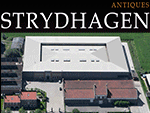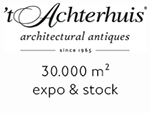|
Raoul Larche was a sculptor of busts, groups, religious compositions, objets d’art and decorative pieces, but in fact he made his debut as a painter and besides his career as a sculptor he continued painting all his life. In the beginning of this career, around 1890, he realised a number of important impressionist paintings, later on symbolist paintings. Blessed with a very individual talent, he was quickly noticed by the masters of modern sculpture of his time. The suggestive power of Larche's work situates him amongst the Art Nouveau artists.
Even though he had his studio in the Rue Mornay No 6 in the 4th arrondissement of Paris, he often stayed in Seine-et-Oise in Coubron (nowadays Seine-Saint-Denis) where the house where he lived and worked still exists. He died on 3 June 1912 after he was hit by a car in the streets of Lagny whilst walking on the arm of his friend, the banker Max. His grave in the cemetery of Coubron is ornated with a reproduction of one of his own sculptures. The municipality placed a memorial in honor of Larche in the town hall park. It is crowned with a bronze group: Les Faunes (The Fauns), a work by the artist himself. Coubron houses several works of Raoul Larche: Bust of Mrs Larche, Ephebe, Oreste. Mrs. Larche suggested to donate works of her husband to the city of Bordeaux on condition that a Salle Raoul Larche would be installed at the Musée de Peinture et Sculpture. On 5 December 1921 the hall was inaugurated, but it was closed in the early 1930s. The square of the town hall Saint-André-de-Cubzac bears his name, as an avenue in Coubron and in Saint-Médard-en-Jalles.
After he studied at the École Nationale Supérieure des Arts Décoratifs, he started in 1878 his studies at the École Nationale Supérieure des Beaux-Arts where he was taught by François Jouffroy (1806-1882), Auguste Dumont (1801-1884), Alexandre Falguière (1931-1900), Jean-Léon Jérôme (1824-1904) and Eugene Dela Planche (1836-1891). He debuted in 1881 in Paris, at the Salon des Artistes Français, where he remained a loyal exhibitor until 1911. He obtained the deuxième Prix de Rome de Sculpture in 1886, the médaille de troisième classe in 1890, the médaille de première classe in 1893, the médaille d’or in 1900 at the Exposition universelle, and finally in 1903 a médaille d’or du Salon. The recipient of France’s highest civilian honour in 1900, the Légion d’Honneur, he was promoted to officier in 1910. As a member of the jury at the École Nationale des Beaux-Arts and at the Salon des Artistes Français, in 1904 he entered the committee of the Société des Artistes Français. In 1920, the Salon organized at the Grand Palais a retrospective exhibition of his oeuvre. On 14 June 1937, all works of Raoul Larche that were still in his studio, were auctioned at the Hôtel Drouot in Paris.
Raoul Larche was one of the many artists who were inspired by Loïe (or Loie) Fuller (1862-1928), a famous American dancer who was the pioneer of modern dance and theater lighting techniques. Due to his design of a lamp in 1901, inspired by the evocative power of this dancer, he belonged to the group of sculptors who broke with academic art and it brought him wide fame. As a result, he created a large series of objets d'art and decorative pieces in bronze and tin (lamps, vases, chandeliers, decorative bowls, etc.) that were cast by the Parisian art foundry Siot-Decauville.
Ca. 1900
Bronze with green patina
Signed on right RAOUL LARCHE and with foundry stamp Siot Decauville Fondeur Paris
H. 45 cm, Diam. base ca. 27 cm
Museums: Agen, Bordeaux, Cette, Dijon, Paris, Saint-Étienne, Roanne, Troyes, Luxemburg.
Sources: Bénézit, E. (vol. 8) (1999), Dictionnaire critique et documentaire des peintres, sculpteurs, dessinateurs et graveurs de tous les temps et de tous les pays par un groupe d’écrivains spécialistes français et étrangers, Paris: Éditions Gründ, p. 277; Thieme, U., & Becker, F. (vol. 22) (1999), Allgemeines Lexikon der bildenden Künstler von der Antike bis zur Gegenwart, Leipzig: E. A. Seemann, p. 380.
|


































